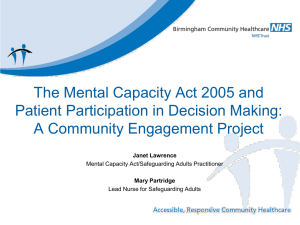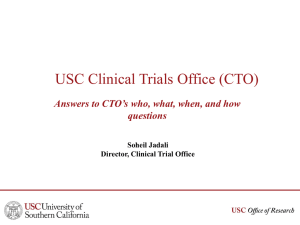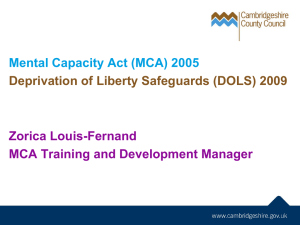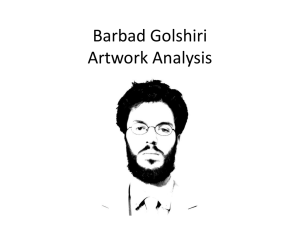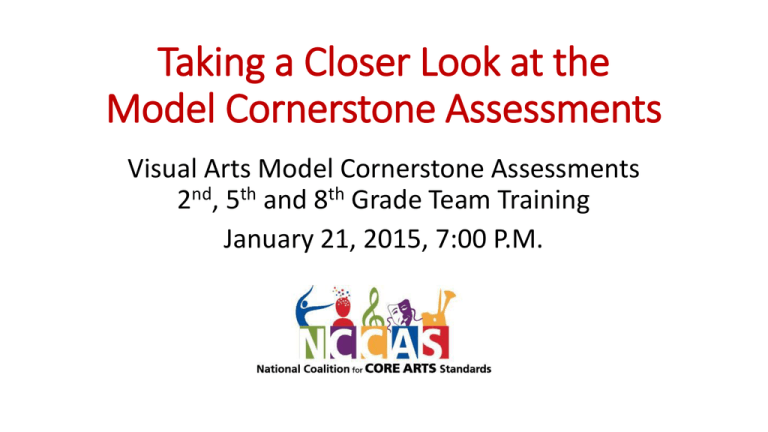
Taking a Closer Look at the
Model Cornerstone Assessments
Visual Arts Model Cornerstone Assessments
2nd, 5th and 8th Grade Team Training
January 21, 2015, 7:00 P.M.
Our Team
Rebecca Belleville, MD,
Karen Bell-Hansen, CA,
Kim Bonney, CA,
Tammi Browning, MI,
Michelle Clark, NM,
Beth Dobberstein, FL,
Tammy Hoppe, IA,
Kathleen Karshner, KY,
Belinda Monn, PA,
Demerice Pallone, MA,
Jerris Palmer, AR,
Rebecca Schuler, NY,
Christine Scott, NY,
Linda St Clair, WA,
Lindsey Tomaso, NE,
Mary Tomczak, AZ,
Kathleen Wyatt, MS,
MCA 8
MCA 2, 5
MCA 8
MCA 2, 5
MCA 2, 5
MCA 5
MCA 2, 5
MCA 2
MCA 2, 5
MCA 2, 5, 8
MCA 8
MCA 8
MCA 2, 5
MCA 8
MCA 2, 5
MCA 8
MCA 5
Bob Sabol
NCCAS Leadership Team;
Visual Arts Model Cornerstone
Assessment Development, Chair;
Visual Arts Model Cornerstone
Assessment Benchmark Pilot 1, Chair;
NAEA Past-President;
Art Education Program, Chair,
Purdue University;
bobsabol@purdue.edu
765-494-3058, office
Web Resources
nationalartsstandards.org
nccas.wikispaces.com
The Timeline
February-April: Collection of Permission Slips and Piloting of assessments
in classrooms.
April 15: Submission of student work samples to designated website
June/July: Adjudication of student work (benchmarking)
September: Posting of student artwork samples on the NCCAS website
literacy.
Let’s Take a Brief Look at the
Structure of the Standards
Standards Framework Overview
National Core Arts Standards
DANCE
MEDIA ARTS
MUSIC
THEATRE
VISUAL ARTS
Feb. 12, 2014
ARTS
ARTISTIC LITERACY
Philosophical Foundations
Artistic
Processes
Creating
Core Arts
Anchor
Standards
3 Common Anchor
Standards
Performing
Lifelong Goals
Discipline Specific Performance Standards
Pre K--High School
Pre K—grade 8
HS Performance
Performance
Standards
Standards
Advanced
(grade by grade)
Accomplished
Proficient
Supplemental Instructional Support Resources
Model Cornerstone Assessments
- Performance Tasks with key traits
- Grades 2, 5, 8
- High School 3 levels of proficiency:
(Proficient, Accomplished, Advanced)
(Dance, Music, Theatre)
Presenting
(Visual Arts)
3 Common Anchor
Standards
Producing
(Media Arts)
Responding
3 Common Anchor
Standards
Connecting
2 Common Anchor
Standards
Discipline specific tools to unpack the standards
Enduring Understandings and Essential
Questions
Process Components and other power verbs that
operationalize the standards
Glossaries and Resources
A Conceptual Framework for Arts Learning
Copyright © 2013 State Education Agency Directors of Arts Education (SEADAE) on behalf of NCCAS. All rights reserved.
www.nationalartstandards.org
Standards Framework Overview
Anchor
Standards
Enduring
Understandings
with Essential
Questions
Performance Standards – pK-8 with
Three Levels of HS Proficiency
Model
Creating – Presenting
Cornerstone
Assessments
Responding – Connecting
Anchor Standards
Anchor standards describe the general knowledge and skill that teachers
expect students to demonstrate throughout their education in the arts. These
anchor standards are parallel across arts disciplines and grade-levels and
serve as a tangible educational expression of artistic literacy.
Enduring Understandings and Essential
Questions
Enduring Understandings
Enduring understandings are statements
summarizing important ideas and core
processes that are central to a discipline and
have lasting value beyond the classroom.
Essential Questions
Essential questions are “questions that are not
answerable with finality in a brief sentence....”
Their aim is to “stimulate thought, to provoke
inquiry, and to spark more questions.”
Jay McTighe and Grant Wiggins
Understanding by Design (ASCD, 2005)
Artistic Processes
Creating
Conceiving and developing new artistic ideas and
work.
Presenting (Performing,
Producing)
Interpreting and sharing artistic work.
Responding
Understanding and evaluating how the arts
convey meaning.
Connecting
Relating artistic ideas and work with personal
meaning and external context.
Performance Standards
Performance Standards are discipline specific, written by grade level for
PreK through 8th grade and for three performance levels (proficient,
accomplished, and advanced) for high school. The performance standards
translate the anchor standards into specific, measurable learning goals.
Key Traits
Key traits are those attributes or characteristics of work that provide evidence
that students have met the standards. They are the “look fors” in the student
work upon which evaluation can be based. Key Traits are listed on MCAs only.
Model Cornerstone Assessments
“In education, what is chosen for assessment signals what is
valued. In other words, the evidence that is collected tells
students what is most important for them to learn. If it is not
assessed, it will likely be regarded as unimportant.”
Jay McTighe and Grant Wiggins,
Understanding by Design (ASCD, 2005)
CONNECTING
Supporting
Instruction
Digging deeper into the Model Cornerstone
Assessments
•
Flexible and adaptable; not mandatory – they are examples or samples
•
College and career ready
•
Obtainable, assessable, and aspirational
•
Aligned with 21st Century Skills: critical thinking, collaboration, communication, and creativity
•
Able to support all media and skill building
•
Deep Life-Long Learning
•
Comprehensive and inclusive of design and technology
•
Supports authentic and formative assessments
MCAs
Model Cornerstone Assessments may address all of the Artistic Processes
(Creating, Presenting, Responding, and Connecting) or they may address one or
more of the Artistic Processes.
Model Cornerstone Assessment have been created for grades bands 2, 5, 8 and for
the three performance levels of Proficient, Accomplished, and Advanced at the
secondary school level.
Model Cornerstone Assessments are designed to reflect Artistic Processes
(Creating, Presenting, Responding, Connecting)
Model Cornerstone Assessments were modeled after “Cornerstone Tasks”
developed by Grant Wiggins and Jay McTighe.
Model Cornerstone Assessments were written by teams consisting of members of
the standards writing teams and other arts educators.
Understanding the Model
Cornerstone Assessment Model
Model Cornerstone Assessment Model
Title and Short Description of the Assessment
Model Cornerstone Assessment Model
Title and Short Description of the Assessment
Strategies for Embedding in Instruction
Model Cornerstone Assessment Model
Title and Short Description of the Assessment
Strategies for Embedding in Instruction
Detailed Assessment Procedures
Model Cornerstone Assessment Model
Title and Short Description of the Assessment
Strategies for Embedding in Instruction
Detailed Assessment Procedures
Key Vocabulary, Knowledge, and Skills
Model Cornerstone Assessment Model
Title and Short Description of the Assessment
Strategies for Embedding in Instruction
Detailed Assessment Procedures
Key Vocabulary, Knowledge, and Skills
Strategies for Inclusion
Model Cornerstone Assessment Model
Title and Short Description of the Assessment
Strategies for Embedding in Instruction
Detailed Assessment Procedures
Key Vocabulary, Knowledge, and Skills
Strategies for Inclusion
Differentiation Strategies
Model Cornerstone Assessment Model
Title and Short Description of the Assessment
Strategies for Embedding in Instruction
Detailed Assessment Procedures
Key Vocabulary, Knowledge, and Skills
Strategies for Inclusion
Differentiation Strategies
Resources, Scoring Devices
Model Cornerstone Assessments on the Website
Digging into the Model
Cornerstone Assessment
Template
National Coalition for Core Arts Standards
(Insert Discipline) Model Cornerstone Assessment: (Insert Grade/HS Level)
Discipline: (insert)
Artistic Processes: (insert)
Title: (insert))
Short Description of Assessment: (insert 3-5 sentences describing the task)
Grade: (insert)
In this MCA you will find: (mark all that apply)
☐Strategies for Embedding in
Instruction
☐ Detailed Assessment
Procedures
☐ Knowledge, Skills and
Vocabulary
☐ Differentiation Strategies
☐ Suggested Scoring Devices
☐ Resources needed for
task implementation
☐ Assessment Focus Chart
☐ Benchmarked Student
Work
☐ Task Specific Rubrics
or Strategies for Inclusion
Estimate Time for Teaching and Assessment: (mark the appropriate box)
(Note: This task will be piloted during the 2014-2015 school year. Once piloted, the estimated time may be revised. If a time is
entered below, it is to assist teachers for planning purposes. If a time is not entered, the developers recognize the task has many
purposes and implementation strategies and times are highly teacher dependent. In all cases, time estimates are to be used as a
guideline.)
☐ Approximately 25-30 hours
☐ To be determine by the individual teacher
Strategies for Embedding in Instruction
[possible sequence & strategies to embed Model Cornerstone Assessment within a classroom unit]
Strategies for Inclusion (Specially designed instruction
Differentiation Strategies (Instructional approaches that
and support for students with disabilities to provide equitable
learning opportunities. This may be filled in by individual
teachers based on their own students’ needs.)
respond to individual student needs and strengths to maximize
student learning and success.)
Resource:
Resources (download April 26, 2014):
http://www.ascd.org/publications/books/100216/chapters/Understanding-Differentiated-Instruction@-Building-a-Foundation-for-Leadership.aspx
http://hepg.org/her-home/issues/harvard-educational-review-volume-83-number-1/herarticle/_1229
Detailed Assessment Procedures [clear outline of procedures necessary to obtain comparable work from multiple
teachers - i.e., coding and file format for preservation of student work (mp3, PDF), etc.]
Knowledge, Skills and Vocabulary
[focusing on concepts required to successfully complete the task]
Key Vocabulary
Knowledge and Skills [other than Key Vocabulary]
Students will:
Scoring Devices
[rubrics, checklists, rating scales, etc. based on the Standards and Traits]
Task Specific Rubrics
Note: The first column will vary depending on discipline specific approach to work.
Build as many rows as needed for this task.
Assessment Focus
Artistic Process or
Process
Components
Enduring Understandings
Insert Artistic Process if applicable (using process components)
Creating
Insert Artistic Process if applicable (using process components)
Presenting
Insert Artistic Process if applicable (using process components)
Responding
Insert Artistic Process if applicable (using process components)
Connecting
Essential
Questions
Anchor
Standards
Key Traits
Performance Standards
(Advanced)
Protecting student privacy and rights
Photo/Media Release and Consent Form
1. It is important that you collect signed copies of the Photo/Media Release and Consent Form for all students
participating in the project.
2. We need signed copies of these forms for all students.
3. You must keep copies of all of the sighed forms on file.
NEXT STEPS
Establishing Professional Learning Communities
I will be setting up grade level (2, 5, 8 grade) PLCs so that we can have occasional Webex meetings to
discuss progress, issues, problems of implementing the MCAs.
Lesson Planning
You will be designing your specific lesson plans to implement the MCAs in your classroom. We require
that you include all aspects of each MCA in your instruction.
Works required
1. You will collecting and submitting work from 20 of your students.
2. Submit all work done by students.
3. Insure that no identifying information about the identity of your students is included on any of the
work submitted. (Code numbers may need to be assigned later, before submission.)
4. Work samples may presented in a variety of forms, depending on the activity being assessed
(videos, studio products, jpeg photos, portfolios, journals, worksheets, rubric responses, etc.).
Selecting Work to be Submitted
Select work from 20 students who you feel have met the standards for the grade level you are
addressing.
Next Steps (cont.)
Permission Slips
1. I will need signed copies of the permission slips.
2. You must store the signed copies of the permission slips and keep them on file.
Uploading student work on MCAs
We will be using a website (TBD) onto which you will load your students’ work. We will provide a training
website and about the procedures we will be using on it.
Your evaluation of the MCAs and our benchmarking process
1. We will be evaluating the effectiveness of the MCAs and the process we will be using to implement
2. During the project we are asking that you make notes or record ideas about issues related to
classrooms.
3. We will provide a formal evaluation instrument to gather your evaluation input.
4. Your input will be used to revise the MCAs, if necessary, and to help develop Professional
art educators use the MCAs in their classrooms and programs.
Next Steps (cont.)
Hitting a moving target
As the project unfolds and questions arise, the NCCAS Leadership Team may need to make adjustments to our process.
The NAEA Convention (March 26-28, New Orleans, LA)
The NAEA convention will be a few weeks before the deadline for uploading your students’ work.
We will be setting up a face to face meeting for the team so that we can meet and talk about finalizing the project.
Brief words of thanks
Model Cornerstone Assessments are a new idea; as pilot teachers you are innovators helping to break new ground and make discoveries.
We expect to learn together and improve the MCA’s as we go through the process thanks to your feedback.
This summer teams of arts educators will “benchmark” the student work received from
you.
Examples of selected student work that meets standards will be posted on
the NCCAS and NAEA websites this coming summer or early fall.
Questions?
Let’s talk.


